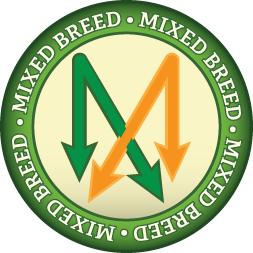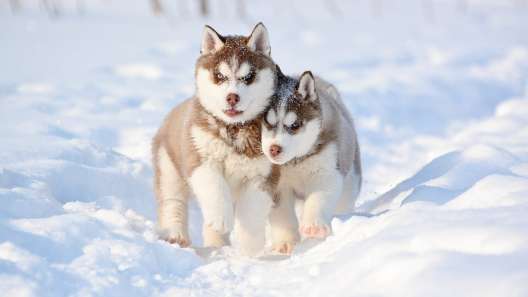
-
Activity Level:
high
-
Shedding Level:
moderate
-
Grooming Level:
moderate
-
Trainability:
moderate
-
Good for Novice Owners:
moderate
-
Adaptability:
moderate
-
Kid/Pet Friendly:
sometimes
-
Prey Drive:
high
-
Watchdog:
very alert
- Average Size: Medium
- Average Lifespan: 12-14 years
Siberian Husky Mix Dog Breed Information
Overview
Temperament
Adaptability
Health
Owner Experience
Grooming
Activity Level
Size
Life Span
Did You Know?
A Siberian Husky Mix is a cross between a Siberian Husky and another dog breed. A mixed dog breed can take on the characteristics of either parent breed or be any combination of both of them. If a Siberian Husky Mix takes after their Siberian Husky parent, they will likely be a high-energy dog that loves its family, has an urge to wander, and needs plenty of mental stimulation to stay happy and healthy. The other parent breed in the mix can have a big effect on a Siberian Husky Mix’s physical traits and personality, so it’s important to talk to the breeder about both of the parent breeds.
Siberian Husky Mixes are usually loving and affectionate towards their family. With proper training and socialization, they get along well with other dogs and children. With a Siberian Husky as a parent, the Siberian Husky Mix will likely have a high prey drive and an urge to wander. Puppies will often take cues on how to behave from their mother, so meeting the mother dog in-person can give you an idea about the temperament of your Siberian Husky Mix. Asking the breeder about the other parent breed in the mix and meeting the mother dog can help you determine what to expect in your Siberian Husky Mix.
A Siberian Husky Mix is moderately adaptable. Because Siberian Huskies are so high energy, they are not a good fit for apartment living. Their endurance, paired with their wanderlust, makes them better-suited for homes with room to run and a securely fenced backyard. They also are better-suited to moderate or colder climates due to their heavy insulating coats. Huskies also do not like to be left alone for long periods of time and are easily bored, so they need plenty of mental stimulation and physical exercise. This could vary depending on the other parent breed in the mix, but you’ll need to be prepared for a puppy that could take after the Siberian Husky.
A mixed breed can sometimes end up with more robust genetics and not be prone to any of the health conditions common to the parent breeds. There is also the potential that they could be prone to conditions of one or both of the parent breeds. Some potential health conditions to be aware of from the Siberian Husky side include eye disorders like Progressive Retinal Atrophy, Corneal Dystrophy, and Cataracts.
To get a full picture of what to be aware of in your Siberian Husky Mix, be sure to ask the breeder about the other parent breed in the mix, the genetic history of the parents, and any relevant health clearances. Knowing this information can give you an idea of what to expect and can help allay concerns about potential health conditions.
A Siberian Husky is highly trainable, but can be stubborn. Usually, obedience training is recommended with Huskies, especially for novice dog owners. Talking with the breeder about the other parent breed can give you a good idea about what range of trainability to expect in your Siberian Husky Mix. Attending training classes with your puppy is always a good idea as there are always new things to learn and will help you be prepared to train your Siberian Husky Mix successfully.
If the Siberian Husky Mix takes after their Siberian Husky parent, their coat will be thick and dense. They’ll shed a lot year-round with heavier shedding seasons twice a year. You can control the shedding and make your dog more comfortable by brushing your dog’s coat often. The other parent breed in the mix may result in a lower-shedding coat or other coat variation, which could affect the grooming level of the coat.
Regardless of coat type, there are other grooming tasks that every dog needs including nail care, dental care, and ear care. Nails that are too long can make movement uncomfortable or painful for your dog. By trimming them monthly, or more often if needed, helps keep nails shorter and movement more comfortable for your dog.
Dental care for dogs is so important, but is also often overlooked. Dental disease is one of the most common, and preventable, health issues in dogs. By brushing your dog’s teeth or using an enzyme toothpaste daily and pairing it with dental chews, special diets, etc., you can reduce the tartar buildup that leads to dental issues like gum disease or tooth decay.
Wax can build up in a dog’s ears and they can collect moisture, dirt, and debris that could lead to ear infections. Dogs with floppy ears are more prone to ear infections simply because they are more likely to trap moisture, dirt, and debris. By regularly checking your dog’s ears and carefully cleaning them, you can help keep your dog’s ears clean and help prevent ear infections.
It’s a good idea to get your Siberian Husky Mix used to having their paws, mouth, and ears handled as a puppy and keep it a positive experience as much as possible. This will make grooming your dog much easier as they continue to grow.
A Siberian Husky Mix is likely to be a high-energy dog that requires a lot of daily exercise and plenty of mental stimulation to stay happy and healthy. Trips to the dog park, hiking, swimming, games of fetch, running, dog sports, and more are all activities that can help your Siberian Husky Mix expend some extra energy. The other parent breed in the cross may result in a slightly lower activity level, but you’ll still need to be prepared for a potential endurance athlete if your puppy takes after their Siberian Husky parent.
The other parent breed in the cross can have a big effect on the size of your Siberian Husky Mix. A Siberian Husky usually stands 20 to 25 inches tall at the shoulder and weighs between 35 and 60 pounds. Asking the breeder about the other parent breed and meeting the mother dog in-person can give you an idea of what size to expect in a Siberian Husky Mix.
A Siberian Husky typically lives 12 – 14 years. The other parent breed in the cross may affect the life expectancy of a Siberian Husky Mix. Talking with the breeder about both parent breeds can give you a better idea of what could be typical for your puppy.
Siberian Huskies were notable Army dogs during World War II. They were popular choices for the Air Transport Command, particularly in their Arctic Search & Rescue Unit. They served in this capacity again for the Byrd Antarctic expeditions.








